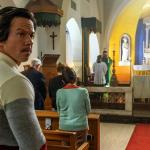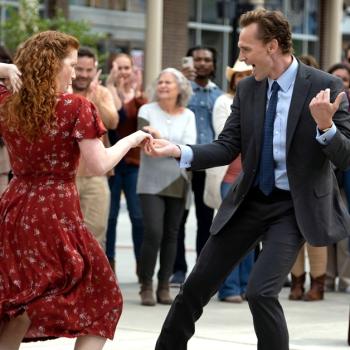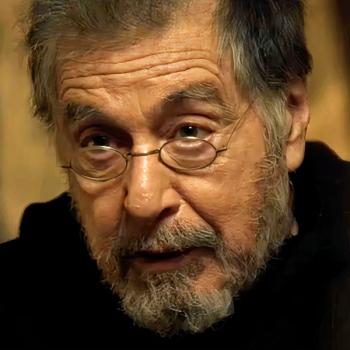
In theaters today (April 13), Father Stu may be the most Catholic major feature film I’ve seen since The Passion of the Christ — and that was one of the most Catholic ones I had seen since The Exorcist.
If you want a rundown of the plot of Father Stu, you can read any of a few dozen reviews (or click here and here to see what I said previously), but that’s not what I wanted to talk about here.
So, what makes Father Stu a Catholic movie, as opposed to just being a faith-based story?
It’s got cursing, fighting, fierce conflict and sin, but it also has truth, beauty, grace and redemption. It may shave several years off, and compress, the story of how non-religious former boxer, bouncer and all-around-tough-guy Stuart Long (Mark Wahlberg) became Father Stu, only to die young of a progressive muscle disorder, but it retains the core message of his life:
The world is a hard place, suffering has value and can be redemptive, and God doesn’t just lay His hand on the godly.
As quoted in The Pillar’s excellent longread on Father Stu, Bishop George Thomas, who ordained Long, recalled:
“I kept hearing the same message over and over again: ‘There is power in suffering, move him forward.’”
Back in 2007, Bishop George Thomas of Helena wasn’t sure whether to ordain Stuart Long to the priesthood.
Seminary formators had raised red flags about Stu, who had an aggressive and debilitating muscle disorder with a poor prognosis. A serious chronic illness didn’t seem like it fit with the ministry of a Catholic priest.
But Bishop Thomas of Helena believed that suffering is a gift in the Christian life — a gift Stu had received in spades.
That’s a fundamental idea in Catholicism – Christ redeemed us through his suffering and death on the cross, and in a mysterious way our suffering, united to his, can be redemptive. That’s what Bishop Thomas remembered in prayer.
Ultimately, the bishop told The Pillar, it was because of Stu’s sufferings — and not despite them — that he decided to ordain Stuart Long a priest.
Friends and I have debated what makes a Catholic story, and what defines the Catholic imagination.
This is just my opinion, but if it isn’t scuffed and dinged, if there isn’t dirt on it and bits of rot somewhere in it along the road to redemption, it’s not a Catholic story.
The Church is 2,000 years old and has been dealing with human failings the entire time, both within herself and in the outside world.
She’s traveled the globe, finding converts in every corner of it, most especially where life is the toughest. Ease, comfort, renown and prosperity are the enemies of true faith.
Christ hangs on our crucifixes for a reason. The Passion narrative is not just the Resurrection, it’s also the Crucifixion.
The Passion of the Christ
That’s something Mel Gibson — a man who’s struggled mightily, mostly with himself — knew in The Passion of the Christ. Rather than a shiny empty cross, he put the blood, pain and dirt of Christ’s final days into sharp focus, illuminating every agonizing step of the Stations of the Cross.
Catholics know that story well, and are asked to walk through it, moment by moment, every Holy Week. No skipping ahead to the Resurrection for us.
That’s a Catholic movie.
The Exorcist
In William Peter Blatty’s The Exorcist, a priest wrestles with his own guilt, shame and doubts to find the strength and faith in himself that will allow him to die for another.
Christ filled him, not with a McMansion and a luxury car, but with the courage to make the ultimate sacrifice.
That’s a Catholic movie.
It’s something about sacramental storytelling.
The ideas I’m talking about aren’t unique to Catholics — nor just to Christianity at large — but there’s something especially powerful about the Church’s potent blend of beauty, transcendence, the supernatural and feet-on-the-ground earthly reality.
When properly formed, Catholic storytellers begin to think not just in words, but also in symbols and sacraments.
Two millennia of striving for holiness in a gritty, grimy, sometimes ghastly world has caused us to raise soaring cathedrals up to heaven, bring glorious life out of stone and glass, and cover canvases and icons with vivid depictions of Christ and His saints.
To me, Catholicism isn’t pale or wispy or sentimental, but bold and in full color.
A Catholic Bond?
Sometimes, a Catholic-ish sensibility pops up in unexpected places.
Last night, I finally got around to watching the most recent James Bond movie, No Time to Die (SPOILERS AHEAD!). It wasn’t much of a Bond movie, because, traditionally, while Agent 007 dispenses swift justice to the guilty, he’s a hedonist and nihilist, albeit a suave and charming one.
But No Time to Die not only gives Bond one true love (which has been done before) but also a child. For her and her mother (and secondarily, the U.K. and the world), he can happily die.
A previous Bond film, Skyfall, took him back to his childhood home, which had a hole for hiding Catholic priests from the Reformation.
It’s up for debate whether Bond was baptized a Catholic, but he sure died like he was.
As Wahlberg said about Father Stu, “it’s tough grace.”
Stuart Long may not have begun life as a Catholic, but he became a symbol for all those who knew him — and now, for the world — of what it means to live, suffer and die in God’s grace.
BTW, here’s a video of my interview with Wahlberg, in which we discuss just that:
Image: Columbia Pictures/PHOTO BY: Karen Ballard/© 2022 CTMG, Inc. All Rights Reserved.
Don’t miss a thing: Subscribe to all that I write at Authory.com/KateOHare














